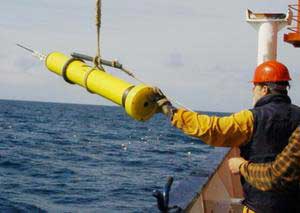ARGO Network Senses Ocean Changes
More than 3,600 robots probe the seas down to 2,000 meters. Scientists worldwide have been capturing and analyzing detailed data about the atmosphere for decades. Information about the oceans has been much more spotty, however. Ships have taken readings along many isolated transects, but each effort has occurred at a moment in time, and significant portions of the seas have gone unexamined.
That is changing. Since 2007 a network of thousands of floating robots covering the seven seas, named Argo, has been generating real-time data for use in ocean and climate research. Each robot probe, a tube a little more than meter long, dives to about 1,000 meters, then drifts locally for nine days. On the 10th day it sinks to 2,000 meters and then rises straight up, sensing temperature and salinity along its ascent. Each probe also measures the subsurface and surface currents that push it around. When a probe surfaces, a satellite picks up the data, and the probe sinks again for another 10-day cycle.
 Each robot uses a hydraulic piston and bladder to dive and surface and lasts about five years. From 700 to 800 new units have been deployed in each of the past several years to replace defunct robots or to beef up the network in remote regions to improve global coverage.
Each robot uses a hydraulic piston and bladder to dive and surface and lasts about five years. From 700 to 800 new units have been deployed in each of the past several years to replace defunct robots or to beef up the network in remote regions to improve global coverage.
The Argo program, named after the mythical Greek ship, is run by 50 research institutions in more than 30 countries. At the end of December 2012 some 3,674 probes were operating across the planet. The data they generate is freely available, and many institutions have begun analyzing it. Among other things, the information is improving climate models and is being compared with traditional data from ships to reveal longer-term trends. As Stephen C. Riser and M. Susan Lozier note in their February 2013 Scientific American article, “Rethinking the Gulf Stream,” “A comparison of the Argo data with ocean observations from the 1980s, carried out by Dean Roemmich and John Gilson of the Scripps Institution of Oceanography, shows that the upper few hundred meters of the oceans have warmed by about 0.2 degree C in the past 20 years. Upper-ocean salinity also increased globally by a small 0.1 percent—yet below a few hundred meters, ocean waters appear to be considerably fresher than in previous decades.” More comprehensive trends will emerge as the Argo network continues into the future.
That is changing. Since 2007 a network of thousands of floating robots covering the seven seas, named Argo, has been generating real-time data for use in ocean and climate research. Each robot probe, a tube a little more than meter long, dives to about 1,000 meters, then drifts locally for nine days. On the 10th day it sinks to 2,000 meters and then rises straight up, sensing temperature and salinity along its ascent. Each probe also measures the subsurface and surface currents that push it around. When a probe surfaces, a satellite picks up the data, and the probe sinks again for another 10-day cycle.
 Each robot uses a hydraulic piston and bladder to dive and surface and lasts about five years. From 700 to 800 new units have been deployed in each of the past several years to replace defunct robots or to beef up the network in remote regions to improve global coverage.
Each robot uses a hydraulic piston and bladder to dive and surface and lasts about five years. From 700 to 800 new units have been deployed in each of the past several years to replace defunct robots or to beef up the network in remote regions to improve global coverage.The Argo program, named after the mythical Greek ship, is run by 50 research institutions in more than 30 countries. At the end of December 2012 some 3,674 probes were operating across the planet. The data they generate is freely available, and many institutions have begun analyzing it. Among other things, the information is improving climate models and is being compared with traditional data from ships to reveal longer-term trends. As Stephen C. Riser and M. Susan Lozier note in their February 2013 Scientific American article, “Rethinking the Gulf Stream,” “A comparison of the Argo data with ocean observations from the 1980s, carried out by Dean Roemmich and John Gilson of the Scripps Institution of Oceanography, shows that the upper few hundred meters of the oceans have warmed by about 0.2 degree C in the past 20 years. Upper-ocean salinity also increased globally by a small 0.1 percent—yet below a few hundred meters, ocean waters appear to be considerably fresher than in previous decades.” More comprehensive trends will emerge as the Argo network continues into the future.
You can return to the main Market News page, or press the Back button on your browser.

